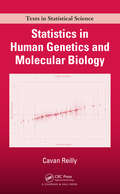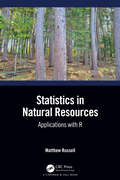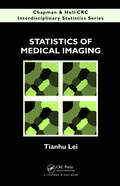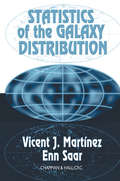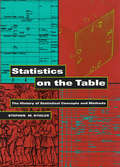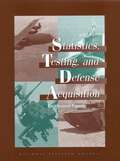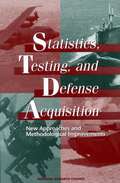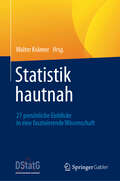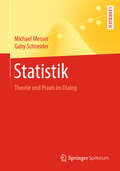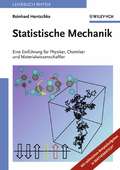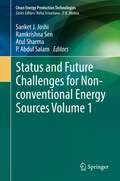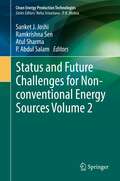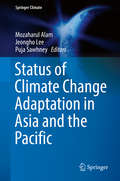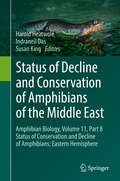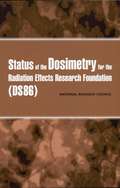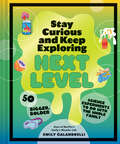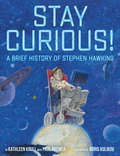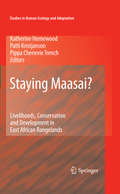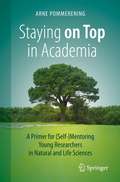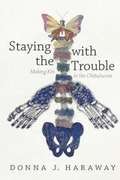- Table View
- List View
Statistics in Human Genetics and Molecular Biology (Chapman & Hall/CRC Texts in Statistical Science)
by Cavan ReillyFocusing on the roles of different segments of DNA, Statistics in Human Genetics and Molecular Biology provides a basic understanding of problems arising in the analysis of genetics and genomics. It presents statistical applications in genetic mapping, DNA/protein sequence alignment, and analyses of gene expression data from microarray experiments.
Statistics in Natural Resources: Applications with R
by Matthew RussellTo manage our environment sustainably, professionals must understand the quality and quantity of our natural resources. Statistical analysis provides information that supports management decisions and is universally used across scientific disciplines. Statistics in Natural Resources: Applications with R focuses on the application of statistical analyses in the environmental, agricultural, and natural resources disciplines. This is a book well suited for current or aspiring natural resource professionals who are required to analyze data and perform statistical analyses in their daily work. More seasoned professionals who have previously had a course or two in statistics will also find the content familiar. This text can also serve as a bridge between professionals who understand statistics and want to learn how to perform analyses on natural resources data in R. The primary goal of this book is to learn and apply common statistical methods used in natural resources by using the R programming language. If you dedicate considerable time to this book, you will: Develop analytical and visualization skills for investigating the behavior of agricultural and natural resources data. Become competent in importing, analyzing, and visualizing complex data sets in the R environment. Recode, combine, and restructure data sets for statistical analysis and visualization. Appreciate probability concepts as they apply to environmental problems. Understand common distributions used in statistical applications and inference. Summarize data effectively and efficiently for reporting purposes. Learn the tasks required to perform a variety of statistical hypothesis tests and interpret their results. Understand which modeling frameworks are appropriate for your data and how to interpret predictions. Includes over 130 exercises in R, with solutions available on the book’s website.
Statistics of Medical Imaging (Chapman & Hall/CRC Interdisciplinary Statistics)
by Tianhu LeiStatistical investigation into technology not only provides a better understanding of the intrinsic features of the technology (analysis), but also leads to an improved design of the technology (synthesis). Physical principles and mathematical procedures of medical imaging technologies have been extensively studied during past decades. However, les
Statistics of the Galaxy Distribution
by Vicent J. Martinez Enn SaarOver the last decade, statisticians have developed new statistical tools in the field of spatial point processes. At the same time, observational efforts have yielded a huge amount of new cosmological data to analyze. Although the main tools in astronomy for comparing theoretical results with observation are statistical, in recent years, cosmologis
Statistics on the Table: The History of Statistical Concepts and Methods
by Stephen M. StiglerThis lively collection of essays examines in witty detail the history of some of the concepts involved in bringing statistical argument "to the table," and some of the pitfalls that have been encountered. The topics range from seventeenth-century medicine and the circulation of blood, to the cause of the Great Depression and the effect of the California gold discoveries of 1848 upon price levels, to the determinations of the shape of the Earth and the speed of light, to the meter of Virgil's poetry and the prediction of the Second Coming of Christ. The title essay tells how the statistician Karl Pearson came to issue the challenge to put "statistics on the table" to the economists Marshall, Keynes, and Pigou in 1911. The 1911 dispute involved the effect of parental alcoholism upon children, but the challenge is general and timeless: important arguments require evidence, and quantitative evidence requires statistical evaluation. Some essays examine deep and subtle statistical ideas such as the aggregation and regression paradoxes; others tell of the origin of the Average Man and the evaluation of fingerprints as a forerunner of the use of DNA in forensic science. Several of the essays are entirely nontechnical; all examine statistical ideas with an ironic eye for their essence and what their history can tell us about current disputes.
Statistics, Testing, and Defense Acquisition: Background Papers
by Michael L. Cohen Duane L. Steffey John E. RolphThe National Academies Press (NAP)--publisher for the National Academies--publishes more than 200 books a year offering the most authoritative views, definitive information, and groundbreaking recommendations on a wide range of topics in science, engineering, and health. Our books are unique in that they are authored by the nation's leading experts in every scientific field.
Statistics, Testing, and Defense Acquisition: New Approaches and Methodological Improvements
by Michael L. Cohen Duane L. Steffey John E. RolphFor every weapons system being developed, the U.S. Department of Defense (DOD) must make a critical decision: Should the system go forward to full-scale production? The answer to that question may involve not only tens of billions of dollars but also the nation's security and military capabilities. In the milestone process used by DOD to answer the basic acquisition question, one component near the end of the process is operational testing, to determine if a system meets the requirements for effectiveness and suitability in realistic battlefield settings. Problems discovered at this stage can cause significant production delays and can necessitate costly system redesign.This book examines the milestone process, as well as the DOD's entire approach to testing and evaluating defense systems. It brings to the topic of defense acquisition the application of scientific statistical principles and practices.
Statistics, Testing, and Defense Acquisition: New Approaches and Methodological Improvements
by Panel on Statistical Methods for Testing Evaluating Defense SystemsFor every weapons system being developed, the U.S. Department of Defense (DOD) must make a critical decision: Should the system go forward to full-scale production? The answer to that question may involve not only tens of billions of dollars but also the nation's security and military capabilities. In the milestone process used by DOD to answer the basic acquisition question, one component near the end of the process is operational testing, to determine if a system meets the requirements for effectiveness and suitability in realistic battlefield settings. Problems discovered at this stage can cause significant production delays and can necessitate costly system redesign.This book examines the milestone process, as well as the DOD's entire approach to testing and evaluating defense systems. It brings to the topic of defense acquisition the application of scientific statistical principles and practices.
Statistik hautnah: 27 persönliche Einblicke in eine faszinierende Wissenschaft
by Walter KrämerWie funktioniert Statistik als Wissenschaft in Deutschland? Wer gibt den Ton an und wo findet der wissenschaftliche Fortschritt statt? Und wer sind die Menschen, die die Statistik in Deutschland in den letzten Jahrzehnten geprägt und angetrieben haben? In diesem Buch kommen 27 von ihnen in persönlichen Interviews zu Wort. Dabei wird schnell klar: Die Wege in die wissenschaftliche Statistik sind sehr vielfältig – und in aller Regel ungeplant. Dies macht es aber umso spannender, sich damit zu beschäftigen! Der inhaltliche Schwerpunkt des Buchs liegt auf Anwendungen in den Wirtschaftswissenschaften, doch natürlich erhält auch die mathematische Statistik als Lieferant der nötigen Werkzeuge einen Ehrenplatz. Wie kann Statistik helfen, Kapital- und Arbeitsmärkte, unser Renten- und Sozialsystem, die demographische Herausforderung oder die Einkommensverteilung besser zu verstehen? Wie und wo bekommt man die nötigen Daten her? Und welche neuen Chancen eröffnen sich durch das Vordringen der Informatik in dieser Wissenschaft? Hier öffnen die zuständigen Experten ihren persönlichen Erfahrungsschatz! Die Interviews – beginnend mit Heinz Grohmann im Jahr 2014 – wurden in unregelmäßigen Abständen in AStA Wirtschafts- und sozialstatistisches Archiv, einer der beiden Vereinszeitschriften der Deutschen Statistischen Gesellschaft, veröffentlicht. Für dieses Buch wurden sie thematisch geclustert und aus heutiger Perspektive erläutert und eingeordnet, so dass sich ein vergleichsweise umfassender und dennoch persönlicher Einblick ergibt. Drei ganz aktuelle Interviews sind exklusiv für diesen Band geführt worden.
Statistik: Theorie und Praxis im Dialog
by Michael Messer Gaby SchneiderDieses Lehrbuch ebnet Mathematik-Studierenden einen Weg in die Statistik, bei dem Theorie und Praxis statistischer Methoden gleichermaßen berücksichtigt werden: Anspruchsvolle mathematische Formulierungen werden konsequent dargestellt und im Rahmen von Beispielanalysen mit praktischen Anwendungen in Verbindung gebracht. Durch unterhaltsame und lehrreiche Dialoge zwischen theoretischen Statistikern und Anwendern (etwa Biologen) wird die Materie lebendig. Das Buch liefert zahlreiche Beispiele unterschiedlichen Detailgrads, bleibt aber trotz der theoretischen Tiefe übersichtlich und sprengt den Rahmen einer Einführung nicht.
Statistische Mechanik: Eine Einführung für Physiker, Chemiker und Materialwissenschaftler
by Reinhard HentschkeDas Lehrbuch ist der optimale Einstieg in die aktuellen Fragen der Thermodynamik und Statistischer Physik. Dabei vollzieht es einen Br ckenschlag zwischen Physik, Chemie und den Materialwissenschaften. Didaktisch besonders ergiebig sind die zahlreichen Beispielaufgaben (mit L sungen), wobei den numerischen L sungen die entsprechenden MATHEMATICA-Programme beigef gt sind. Damit ist der Band zugleich auch eine Einf hrung in die rechnergest tzten Methoden der statistischen Physik. Neben den Grundlagen des Fachs widmet sich das Buch Themen wie Phasen berg ngen, Systemen ohne direkte Wechselwirkung, Fluktuationen sowie Anwendungen von Monte-Carlo-Simulationen. Ziemlich umfangreich sind auch die Ausf hrungen zur Physik der Weichen Materie. Dies entspricht dem enormen Bedeutungszuwachs, den der Bereich in den letzten Jahren erlebt hat. Bei der Darstellung dieses Grenzgebiets zwischen Physik, Physikalischer Chemie und den Materialwissenschaften steht sein interdisziplin rer Charakter im Vordergrund. Studenten wie Dozenten d rfte die jederzeit klare und jederzeit verst ndliche Darstellung berzeugen. Aufgabenstellungen und deren L sungen sind die gro e St rke des Buches. Didaktisch besonders wertvoll werden diese nicht zuletzt durch die Integration von MATHEMATICA in die numerischen L sungen. So dienen die Aufgaben nicht nur der Vertiefung des Gelernten, sondern bieten Studenten auch Gelegenheit, sich mit rechnergest tzten Methoden der statistischen Physik vertraut zu machen. Und wer seine Kenntnisse dar ber hinaus erg nzen und vertiefen m chte, wird im kommentierten Literaturverzeichnis f ndig.
Status and Dynamics of Forests in Germany: Results of the National Forest Monitoring (Ecological Studies #237)
by Nicole Wellbrock Andreas BolteThis book is an open access publication.Forest ecosystems in Central Europe are changing as a result of anthropogenic influences and changing climate conditions. As such, a large-scale monitoring programme was undertaken in order to understand the influence of site modification, deposition of air pollutants, and climate. This book presents the scientific findings of this study for Germany, including the major challenges with regard to the future preservation and management of forest ecosystems under environmental change. In addition, it addresses a number of central questions: what are the main factors affecting forest stands and soil integrity? How, and how rapidly, are forest ecosystems changing? How diverse are the changes across Germany? What will be the main risks in sustainable forest management in the future? And how can policy support the development and maintenance of adaptive and resilient forests that provide essential ecosystem services, today and in the future? Helping readers understand the importance of soils and related ecosystem processes for future sustainable forestry, and sharing essential findings on environmental change and related changes in forest status and dynamics, the book is a valuable resource for researchers and policymakers interested in science-based decisions.
Status and Future Challenges for Non-conventional Energy Sources Volume 1 (Clean Energy Production Technologies)
by P. Abdul Salam Atul Sharma Ramkrishna Sen Sanket J. JoshiThis book highlights recent advancements in such an important topic, through contribution from experts demonstrating different applications in ‘day-to-day’ life, both existing and newly emerging non-biological technologies, and thought provoking approaches from different parts of the world, potential future prospects associated with some frontier development in non-conventional energy sources. It covers different types of natural energy sources such as: Ocean, Tidal and Wave energy; Nuclear energy; Solar cells; Geothermal energy; Hydrogen Fuel; Photovoltaic modules; Gas hydrates; Hydrate-based Desalination Technology; and Hydrothermal Liquefaction of Kraft Lignin/ Lignocellulosic Biomass to Fuels and Chemicals. This book is a comprehensive and informative compilation for international readers, especially undergraduate and post graduate students and researchers.
Status and Future Challenges for Non-conventional Energy Sources Volume 2 (Clean Energy Production Technologies)
by P. Abdul Salam Atul Sharma Ramkrishna Sen Sanket J. JoshiThis book highlights recent advancements in such an important topic, through contribution from experts demonstrating different applications in ‘day-to-day’ life, both existing and newly emerging biological technologies, and thought provoking approaches from different parts of the world, potential future prospects associated with some frontier development in non-conventional energy sources. It covers different aspects of cellulosic and lignocellulosic biomass; Cellulosics Biorefinery; Algal Biofuels; Biodiesel; Bioethanol; Microbial Fuel Cells; Biofuel cells; and biohydrogen production. This book is a comprehensive and informative compilation for international readers, especially undergraduate, post graduate students and researchers.
Status of Climate Change Adaptation in Asia and the Pacific (Springer Climate)
by Mozaharul Alam Jeongho Lee Puja SawhneyThis volume provides an overview of the climate change adaptation objectives set, actions taken, and challenges faced by several countries in the Asia-Pacific region. The majority of the populations in this region struggle to make a living from subsistence agriculture, and livelihoods are highly dependent on natural ecosystem services which are likely to be severely affected by climate change. Cases discussed in this book highlight successes made by governments towards achieving adaptation objectives, and efforts required to overcome challenges. While significant economic advances have been made, the pace of growth has been slow to impact the lives of a majority of the people who live below the poverty line. The chapters highlight adaptation actions for protecting people and their livelihoods in priority sectors, maintaining food and water security, supporting socio-economic stability including poverty reduction, and climate risk management. This book also maximizes readers' insights into the knowledge gaps and limitations of stated adaptation goals, and the bottlenecks that hinder implementation in different regions.
Status of Decline and Conservation of Amphibians of the Middle East: Amphibian Biology, Volume 11, Part 8 Status of Conservation and Decline of Amphibians: Eastern Hemisphere
by Susan King Indraneil Das Harold HeatwoleAmphibians by virtue of their thin, moist, permeable skins are poorly protected from harsh environments and are especially susceptible to chemical changes, desiccation, and alteration of their habitat. Accordingly, it is not surprising that they manifest exceptionally high rates of extinction and suffer more severe declines than do most other taxa in an environment undergoing unprecedented anthropogenic change. They are especially important to study as they serve as an early-warning system portending changes that are beginning to engulf more resistant species, including our own.The current volume covers the 14 countries of the Middle East, each written by a specialist, and is part of the Amphibian Biology series.
Status of the Dosimetry for the Radiation Effects Research Foundation (DS86)
by Committee on Dosimetry for the Radiation Effects Research FoundationThe Committee on Dosimetry for the Radiation Effects Research Foundation (RERF) was set up more than a decade ago at the request of the U.S. Department of Energy. It was charged with monitoring work and experimental results related to the Dosimetry System 1986 (DS86) used by RERF to reconstruct the radiation doses to the survivors in Hiroshima and Nagasaki. At the time it was established, DS86 was believed to be the best available dosimetric system for RERF, but questions have persisted about some features, especially the estimates of neutrons resulting from the Hiroshima bomb. This book describes the current situation, the gamma-ray dosimetry, and such dosimetry issues as thermal-neutron discrepancies between measurement and calculation at various distances in Hiroshima and Nagasaki. It recommends approaches to bring those issues to closure and sets the stage for the recently convened U.S. and Japan Working Groups that will develop a new dosimetry for RERF. The book outlines the changes relating to DS86 in the past 15 years, such as improved numbers that go into, and are part of, more sophisticated calculations for determining the radiations from bombs that reach certain distances in air, and encourages incorporation of the changes into a revised dosimetry system.
Staub: Natürliche Quellen und Mengen (essentials)
by Robert TrierweilerDieses essential beinhaltet Informationen zu den natürlichen Staubquellen, den unterschiedlichen Entstehungsprozessen und den Mengen der natürlichen Staubemissionen. Die Bildungsmechanismen von Primärpartikeln und Sekundärpartikeln werden beschrieben und die wichtigsten Präkursoren werden genannt. Daneben werden Schätzwerte für die globalen Emissionswerte von Primärpartikeln und Sekundärpartikeln sowie von Präkursoren zusammengetragen.
Stay Curious and Keep Exploring: 50 Amazing, Bubbly, and Creative Science Experiments to Do with the Whole Family
by Emily CalandrelliFrom the host of Netflix's Emily's Wonder Lab and FOX's Xploration Outer Space comes a book featuring 50 experiments that introduce the wonders of science to the whole family. MIT engineer Emily Calandrelli shares the science behind each experiment while showing you where to find STEAM concepts in the world around you. You'll learn how to think like a scientist with Make a Hypothesis! and Try This! prompts, where you can experiment within the experiment. With Calandrelli's expert guidance, illustrations throughout, and easy-to-find grocery items, you can make: An alien hovercraft to learn how an air hockey table worksGlow in the dark paint to learn about ultraviolet lightDelicious ice cream to learn about supercoolingOobleck to learn why ketchup is so hard to get out of the bottle With chapters like Magic Tricks, Kitchen Science, and Fun with Physics, this book is packed with experiments that will delight little scientists and their lab assistants. Grab your goggles and a family member to get started on a journey to spark curiosity, critical thinking, and fun family times!
Stay Curious and Keep Exploring: 50 Bigger, Bolder Science Experiments to Do with the Whole Family
by Emily Calandrelli#1 New York Times Best Seller The national-bestselling, must-have science experiment series is back! MIT engineer Emily Calandrelli, host of Netflix’s Emily’s Wonder Lab and FOX’s Xploration Outer Space, is taking curiosity to the next level with 50 big, bold, brand-new experiments that sparkle, bubble, and explode. With this follow-up to the national bestseller Stay Curious and Keep Exploring, scientists of all ages will have a blast learning about STEAM concepts, playing, discovering spectacular Did You Know? facts, and being introduced to Who to Know, diverse biographies of rock stars in the science and technology world. Using easy-to-find items you'll learn to think like a scientist and conduct jaw-dropping experiments, including: Color-changing slimes to discover if dogs really do see the world in black and white A glow-in-the-dark jellyfish to explore the science behind bioluminescence An unpoppable bubble to learn about why toothpaste never dries out Egg geodes to play with supersaturated liquids and crystallization And more! Get ready to explore subjects like Superhero Science, Kitchen Science Lab, and Science in Color. This latest installment of the Stay Curious and Keep Exploring series is sure to light sparks of curiosity and fuel a passion for science.EVERYONE LOVES EMILY: Common Sense Media calls Emily Calandrelli "the science teacher we all wish we had as young kids." And Bill Nye the Science Guy celebrated the first Stay Curious book with these words: "Here are 50, count 'em, 50 home experiments you can count on. Each is a crowd, or home experimenter, pleaser. Emily wrote this book for kids of all ages, and it’s full of references to women who changed the world—with science. It doesn’t matter where you start—be curious; open to any page; take some notes; Emily will keep you exploring." This new volume features 50 brand-new experiments to keep the fun and learning going. GREAT FOR SCIENCE FAIR & HOMESCHOOL CURRICULUM: A must-have for parents and homeschool educators! Colorful illustrations accompany every experiment, along with instructions and materials you'll need to get started, sections to record notes, and real-life examples connecting your STEAM experiment to the world around you. There are also fascinating facts about important people to know in science history. GIFT FOR SCIENCE KIDS & NON-SCIENCE KIDS: With experiments that use supplies that can be easily found at home or online, this book makes a fantastic gift for parents, kids, clubs, schools, and teachers for events from playdates and birthday parties to rainy-day indoor activities.Perfect for: Fans of Emily’s Wonder Lab, Emily Calandrelli and her social media channels, and Stay Curious and Keep Exploring looking for their next experiment book Parents, grandparents, caregivers, and teachers looking for engaging activities and STEAM projects for kids ages 5-12 Birthday, graduation, holiday, or summer activity gift for kids and families interested in science and encouraging STEAM learning Classroom guide or gift for teachers Readers of The Daring Book for Girls, The Dangerous Book for Boys, Geek Dad, and Awesome Science Experiments for Kids
Stay Curious!: A Brief History of Stephen Hawking
by Kathleen Krull Paul BrewerA picture-book biography about science superstar Stephen Hawking, whose visionary mind revolutionized our concept of reality and whose struggle with ALS inspired millions. Perfect for parents and teachers looking to instill curiosity and a love for STEM.As a young boy, Stephen Hawking loved to read, stargaze, and figure out how things worked. He looked at the world and always asked, Why?He never lost that curiosity, which led him to make groundbreaking discoveries about the universe as a young man. Even being diagnosed with ALS didn't slow Stephen down. Those questions kept coming. As his body weakened, Stephen's mind expanded--allowing him to unlock secrets of the universe and become one of the most famous scientists of all time.Stephen always approached life with courage, a sense of humor, and endless curiosity. His story will encourage readers to look at the world around them with new eyes.
Staying Maasai?
by P. Trench Patti Kristjanson Katherine HomewoodThe area of eastern Africa, which includes Tanzania and Kenya, is known for its savannas, wildlife and tribal peoples. Alongside these iconic images lie concerns about environmental degradation, declining wildlife populations, and about worsening poverty of pastoral peoples. East Africa presents in microcosm the paradox so widely seen across sub Saharan Africa, where the world's poorest and most vulnerable populations live alongside some of the world's most outstanding biodiversity resources. Over the last decade or so, community conservation has emerged as a way out of poverty and environmental problems for these rural populations, focusing on the sustainable use of wildlife to generate income that could underpin equally sustainable development. Given the enduring interest in East African wildlife, and the very large tourist income it generates, these communities and ecosystems seem a natural case for green development based on community conservation. This volume is focused on the livelihoods of the Maasai in two different countries - Kenya and Tanzania. This cross-border comparative analysis looks at what people do, why they choose to do it, with what success and with what implications for wildlife. The comparative approach makes it possible to unpack the interaction of conservation and development, to identify the main drivers of livelihoods change and the main outcomes of wildlife conservation or other land use policies, while controlling for confounding factors in these semi-arid and perennially variable systems. This synthesis draws out lessons about the successes and failures of community conservation-based approach to development in Maasailand under different national political and economic contexts and different local social and historical particularities.
Staying on Top in Academia: A Primer for (Self-)Mentoring Young Researchers in Natural and Life Sciences
by Arne PommereningThe pace of change in academia is ever increasing, which makes it difficult for anyone to stay up to date with what may be the right long-term strategy, or even the next step in mastering a PhD or to secure a fruitful academic career. Academic mentoring has proved to be helpful to many young researchers in difficult situations and mentoring programmes have been launched at many universities. In its most basic meaning, mentoring is a goal-oriented off-line conversation between a more experienced (mentor) and a less experienced (mentee) person with the objective to empower the mentee to make important work-related decisions. The first chapter of the book offers an introduction to academic mentoring and provides an overview of what academic mentoring entails. In the following chapters, important topics are discussed that may come up in mentoring conversations. These include scientific thinking, doctoral studies, behaviour and disappointments, scientific storytelling, teaching, scientific presentations, early career years, research cooperation, job applications and basic data management. The discussions in each of these chapters were designed with a view to provide food for thought and to invite self-reflection as well as continued discussions with peers and mentors. The book is written in a highly accessible style whilst restricting each chapter to the most essential information so that reading them can be accommodated in any busy schedule. It is not limited to any particular university or geographic region, since the author has worked in a number of different countries and encountered many different academic cultures. The text is also a useful handbook and reference to go with mentoring programmes.
Staying with the Trouble: Making Kin in the Chthulucene
by Donna J. HarawayIn the midst of spiraling ecological devastation, multispecies feminist theorist Donna J. Haraway offers provocative new ways to reconfigure our relations to the earth and all its inhabitants. She eschews referring to our current epoch as the Anthropocene, preferring to conceptualize it as what she calls the Chthulucene, as it more aptly and fully describes our epoch as one in which the human and nonhuman are inextricably linked in tentacular practices. The Chthulucene, Haraway explains, requires sym-poiesis, or making-with, rather than auto-poiesis, or self-making. Learning to stay with the trouble of living and dying together on a damaged earth will prove more conducive to the kind of thinking that would provide the means to building more livable futures. Theoretically and methodologically driven by the signifier SF--string figures, science fact, science fiction, speculative feminism, speculative fabulation, so far--Staying with the Trouble further cements Haraway's reputation as one of the most daring and original thinkers of our time.
Steady Glide Dynamics and Guidance of Hypersonic Vehicle
by Liang Yang Hao Zhou Wanchun Chen Wenbin YuThis book presents the latest researches on hypersonic steady glide dynamics and guidance, including the concept of steady glide reentry trajectory and the stability of its regular perturbation solutions, trajectory damping control technique for hypersonic glide reentry, singular perturbation guidance of hypersonic glide reentry, trajectory optimization based on steady glide, linear pseudospectral generalized nominal effort miss distance guidance, analytical entry guidance and trajectory-shaping guidance with final speed and load factor constraints. They can be used to solve many new difficult problems in entry guidance. And many practical engineering cases are provided for the readers for better understanding. Researchers and students in the fields of flight vehicle design or flight dynamics, guidance and control could use the book as valuable reference.
